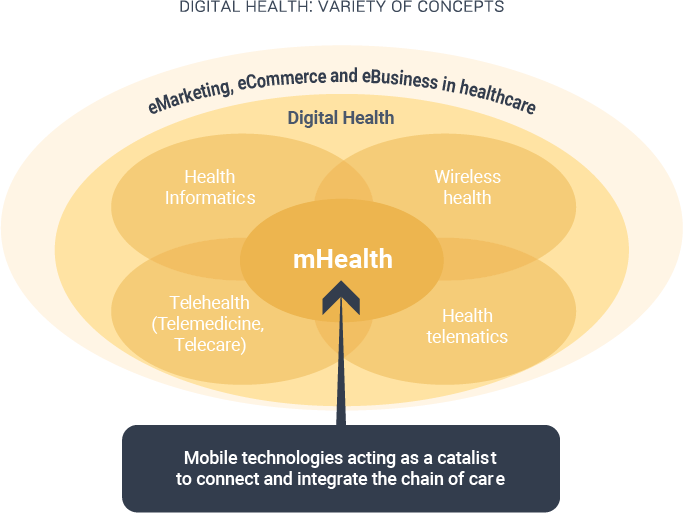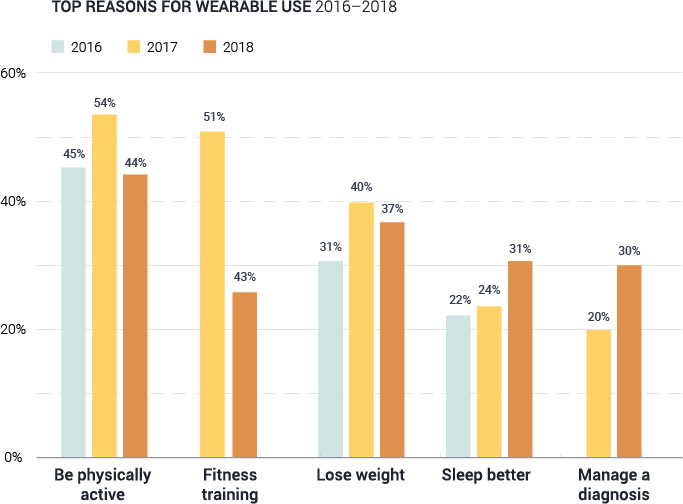Chronic disease management: The era of patient empowerment
09 October 2019
The Human Body Is Becoming The Biggest Data Platform
• Healthcare generates 5% of all the data in the world (roughly 2.2 zettabytes) which need to be stored, retrieved and analyzed
• By 2030, the healthcare industry should generate more than 23 zettabytes of data; roughly the total amount of data created globally in 2017 across all sectors.
• Nevertheless, healthcare is yet one of the least digitalized industries.
• As a consequence, digital companies are now shifting away from wellness management to managing health conditions such as chronic diseases.
A Snapshot Of Chronic Diseases
• Chronic diseases are now the most significant cause of death and disability worldwide.
• Chronic diseases account for 90% of the U.S. $3.3tn annual Health Care expenditure.
• According to Zion Market Research, the global chronic disease management market is expected to grow from $3.9bn in 2018 to $10.3bn by 2024, or a CAGR of 17.5%.
• The main drivers behind the growing interest in the chronic diseases segment in digital healthcare are as follows:
• Too many patients with chronic diseases.
• Unhealthy habits and an increasingly aged population result in the broader spread of chronic diseases.
• Too few physicians.
• Without a change in primary care delivery, estimates point to a deficit of between 43k and 120k physicians in the U.S. by 2030.
• High disease-related costs.
• 90% of U.S. total healthcare expenditure is related to the treatment of chronic conditions.
Digital Health Technology Is Driving The Evolution Of Healthcare
• Digital health engages people to live healthier.
• Preventing the impact of chronic disease through a better lifestyle (nutrition habits, weight, and activity levels).
• Increasing awareness and education through health promotional messages and public health campaigns.
• Enabling the physician to have a closer overview of their patients through the information collected by the patients themselves.
• Motivating patients into action.
• The adoption of wearables to manage a diagnosis has increased as of late, as the technology is proving to be useful.
• Digital health reduces the overall healthcare spending around the world.
• Decreasing more expensive diseases-related medical costs.
• Reducing the number of doctors' visits and consultations.
• Increasing medication adherence.
• Digital health improves the efficiency of healthcare providers.
• Allowing fewer doctors to manage more patients.
• Promoting patient safety by reducing medical errors.
• Facilitating access of patients living in geographically remote areas including people living in vulnerable and isolated situations.
Digital Health Translates Data Into Value
• B2B strategic partnerships for a B2C market: Digital companies are playing across the entire patient care journey, through strategic alliances with healthcare providers, distributors, and payers.
• They provide patients with support for almost any condition stage.
• One tool for different diseases: most chronically ill patients suffer from more than one chronic condition.
• Offer digital health companies the possibility to expand their market.
• A combination of digital health technologies could provide a comprehensive and effective solution to manage chronic conditions.
• mHealth: Mobile technologies (Smart wearables, mobile phones,and personal assistants) help continuously track vital signs and healthrelated data.
• It aims at improving health conditions by motivating behaviorchange through personalized coaching, real-time alerts, reminders of medicine intake, community support, online consultation, and feedback from healthcare providers.
• An exponential increase in computational power, together with improvements in artificial intelligence, big data, machine learning, as well as blockchain, will make better use of the vast amount of data produced daily by healthcare systems.
• Extracting meaningful information and providing automation and customization of the treatment.
• Increasing the security, privacy, and interoperability of health data.
Catalysts:
• The Centers for Medicare and Medicaid (CMS) are promoting digital therapy.
• In 2018 CMS introduced the reimbursement of remote patient monitoring devices.
• The U.S. Food and Drug Administration (FDA) is speeding up the release of digital therapeutics.
• A software-as-a-medical-device (SaMD) provider might be able to fast-track premarket review.
• An essential link in the chain of care: Deployment of 5G will enable faster and more reliable connections.
• Improving real-time monitoring and communication.
• Connecting a massive number of objects.
• Reducing the power consumption of smart wearable devices
Risks:
• Privacy and data security remain a concern.
• According to The Economist, almost one-quarter of data breaches in the U.S. are healthcare related.
• Regulations must be updated to reflect technological advancements.
• A lack of evidence supporting digital health's clinical outcomes could hinder its adoption.
• Lack of reimbursement standards has proven to be a hurdle for digital health and may discourage investments.
Bottom line:
- Chronic diseases is rapidly growing.
- Chronic diseases represent a huge market and a high unmet medical need, legacy solutions are showing efficacy neither for the healthcare sector nor for patients.
- Digital health is a cost-effective revolutionary tool.
- Adding value to users’ health and healthcare providers, digital companies are spreading over the entire chain of care by creating a connected ecosystem.
- The chronic disease management market is the perfect opportunity for big tech companies like Google (GOOGL US) and Apple (AAPL US) to enter into healthcare.
- As a result, smaller players such as Livongo (LVGO US) could become M&A targets
- Big tech will need to either build or buy the clinical expertise needed to compete in this market segment.
- As a result, smaller players such as Livongo (LVGO US) could become M&A targets
Explore:
Disclaimer
This report has been produced by the organizational unit responsible for investment research (Research unit) of atonra Partners and sent to you by the company sales representatives.
As an internationally active company, atonra Partners SA may be subject to a number of provisions in drawing up and distributing its investment research documents. These regulations include the Directives on the Independence of Financial Research issued by the Swiss Bankers Association. Although atonra Partners SA believes that the information provided in this document is based on reliable sources, it cannot assume responsibility for the quality, correctness, timeliness or completeness of the information contained in this report.
The information contained in these publications is exclusively intended for a client base consisting of professionals or qualified investors. It is sent to you by way of information and cannot be divulged to a third party without the prior consent of atonra Partners. While all reasonable effort has been made to ensure that the information contained is not untrue or misleading at the time of publication, no representation is made as to its accuracy or completeness and it should not be relied upon as such.
Past performance is not indicative or a guarantee of future results. Investment losses may occur, and investors could lose some or all of their investment. Any indices cited herein are provided only as examples of general market performance and no index is directly comparable to the past or future performance of the Certificate.
It should not be assumed that the Certificate will invest in any specific securities that comprise any index, nor should it be understood to mean that there is a correlation between the Certificate’s returns and any index returns.
Any material provided to you is intended only for discussion purposes and is not intended as an offer or solicitation with respect to the purchase or sale of any security and should not be relied upon by you in evaluating the merits of investing inany securities.
.png)
.png)
.png)
.png)



